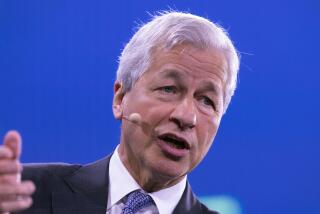Wary Eyes Cast on Test of Nasdaq’s New Trading Rules
The Nasdaq Stock Market is declaring the pilot program for its new trading rules an apparent success, after analyzing first-day data on the 50 stocks in the program.
But many longtime Nasdaq critics say they want to see whether the key goal of the new rules--fairer stock prices for small investors, without a more volatile market--is met in the months ahead.
The new trading rules are supposed to allow investors to get inside brokerages’ official “bid” (sell) and “asked” (buy) prices for Nasdaq stocks by forcing brokerages to display on the nationwide, electronic Nasdaq system any prices better than what the brokerages themselves set.
Previously, if a brokerage listed a stock as $20 bid, $21 asked and an investor tried to offer a better price--say, $20.50--the brokerage wasn’t obligated to show that offer to the marketplace.
Now, for the 50 stocks in the pilot program that began Monday (and for all others as they are phased into the program between now and September), the market must be transparent: The best bid and asked offers should be visible to all, so investors can trade with each other if brokerages aren’t willing to meet those better prices.
*
Here’s what Nasdaq says it saw on Monday in the pilot program’s 50 stocks, which included major names such as Microsoft and Amgen and smaller ones such as Men’s Wearhouse:
* The mean difference, or “spread,” between bid and asked prices was 12.5 cents (one-eighth) 52.1% of the time. In contrast, the 50 stocks traded with a 12.5-cent spread an average of just 23.1% of the time in the 20 prior trading days. (Each stock is equally weighted for the calculation.)
* The mean bid-asked spread was greater than 25 cents for just 22.5% of the time Monday, down from 43.7% in the 20 prior trading days.
* In dollar terms, the mean spread for the 50 stocks narrowed to 24 cents Monday from 36 cents in the 20 prior trading days, a one-third decline.
At the same time, Nasdaq said that volatility, liquidity (the ability to easily trade quantities of stock) and depth (the number of shares offered at specific prices) did not worsen on Monday.
A major fear with the new trading rules is that brokerages, facing lower trading profits as they are forced to narrow their own bid and asked spreads to compete with customers’ better orders, won’t provide the market liquidity they had before. In fact, under the pilot program brokerages are required to stand ready to trade just 100 shares of a given stock for their own accounts--down from the 1,000-share minimum they must be willing to trade in the case of all other Nasdaq stocks.
In practice Monday, however, Nasdaq said 56.3% of brokerage quotes for the 50 pilot stocks were for 1,000 shares or more, suggesting continued liquidity for many issues.
But some Nasdaq watchers are suspicious. David Whitcomb, a professor of finance at Rutgers University who has studied Nasdaq closely, warns that brokerages “may feel it’s in their interest to make a tight market [in terms of spreads] at least for the first month,” because there are elements of the pilot program--including the reduction in the minimum block of stock they must be willing to buy or sell themselves--that the industry would like the Securities and Exchange Commission to extend to all Nasdaq stocks.
What’s more, though spreads may be narrower, the quality of the execution of investors’ orders under the new system still must be quantified.
Inflation-Indexed Bonds: Treasury Secretary Robert E. Rubin on Tuesday gave final details on the government’s new inflation-indexed bonds. The first offering will be for $7 billion of 10-year notes on Jan. 29. Minimum bid: $1,000.
As previously reported, the bonds will compensate owners for any rise in inflation: The bonds’ principal value will be increased each year by the percentage change in the consumer price index.
The big remaining question: Protected from inflation, what “real return” will investors demand on the bonds in the form of the interest yield? The market began to answer that Tuesday, as the 10-year notes began trading on a “when-issued” basis. By day’s end, the notes’ anticipated yield was 3.35%--somewhat below the 3.5% many experts had predicted. That doesn’t mean 3.35% will be the final yield when the auction occurs, of course, but it gives an idea of what investors are thinking.
(BEGIN TEXT OF INFOBOX / INFOGRAPHIC)
Tighter Spreads
The bid and asked price spreads on the first 50 Nasdaq stocks trading under new rules that took effect Monday narrowed--a sign investors are getting better prices, Nasdaq says. Mean spreads for the 50 stocks on Monday versus in the 20 trading days prior: *--*
Monday 20 days prior Less than or equal to 1/4 77.5% 56.3% Greater than 1/4 22.5% 43.7%
*--*
Source: Nasdaq Stock Market
More to Read
Inside the business of entertainment
The Wide Shot brings you news, analysis and insights on everything from streaming wars to production — and what it all means for the future.
You may occasionally receive promotional content from the Los Angeles Times.










